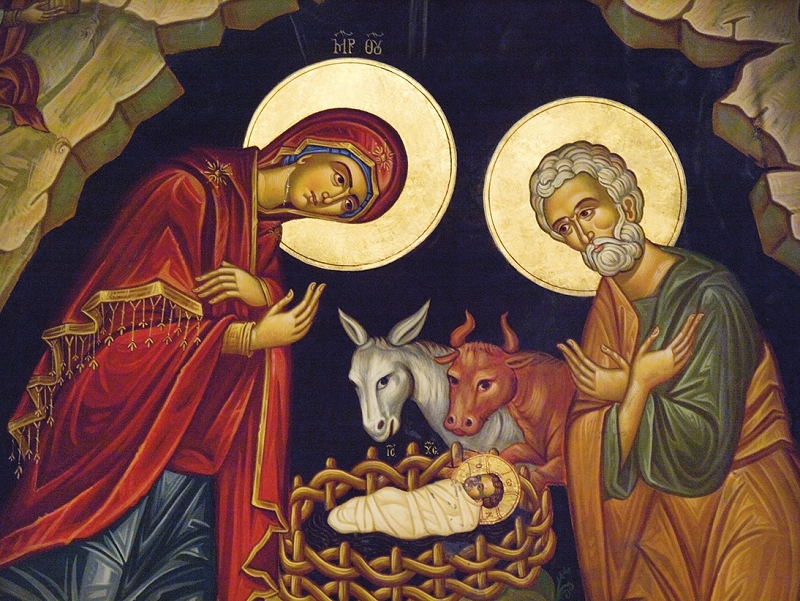Following in the steps of Jesus
Travelling around the Holy Lands of Israel or what it means to be a pilgrim nowadays
"To this very day we still keep a little mother-of pearl cross and a bronze crucifix, a cherished gift from relatives who went to the Holy Lands at the beginning of last century. Now we can also proudly add "Hajji" in front of our family name (which, until a few decades ago, was considered in Bulgaria as prestigious as noble titles were elsewhere in the world. The Holy Lands have always been the main destination of Christian pilgrimage. God chose these lands to be incarnated and to reveal Himself to humanity as Deus homo (God-man). It was the place where Christ was born, where he spent most of his days on Earth, where he was crucified, where he resurrected and ascended…"

Our pilgrimage was incomparably shorter and easier than the one of earlier Hajji as they had to travel for months by ships, camels and mules in order to take from the holy fire of divine light. Nevertheless, it was still an invaluable lesson because, while you are tracing the footsteps of the God-man in the Holy Lands, rather than just reading about it the Gospels, you are nourishing not only your mind, but also your senses, and most importantly – your heart.
It is in our hearts that we cherish the eternal light which first shone bright in the morning skies two thousand years ago, heralding the birth of the Messiah. Bethlehem is located only twenty kilometres south of Jerusalem in the hilly region of Galilee, which is now notorious for its frequent outbreaks of violence; yet to us it appeared to be just a small peaceful provincial city. Refugees from the former Palestinian territories outnumber the Christian population, but there is an agreement which states that the mayor and most councillors must be Christians.
The Manger of the Infant
The Church of the Nativity, which is built over the sacred cave, closely resembles a fortress. It is honoured as the oldest functioning Christian church. This place has been attracting pilgrims for more than sixteen centuries - since 326. It was the year when the mother of the Roman Emperor Constantine the Great –Empress Helena, went searching for the cave where Christ was born according to the gospel of Luke.
On an early Sunday morning we stepped over the threshold of this holy place together with some of the most fervent Bethlehem Christians. We descended into the famous cave following a narrow stairway. There is a 14-point silver star set into the floor of the Grotto with an inscription in Latin: „Here of the Virgin Mary Jesus Christ was born."
We waited for our turn to bow down and touch with our foreheads this holy spot. The infant's manger was in a niche in the wall. There is no altar in the church and the priest held a mass in front of a niche with images of the nativity above the star. Gradually the small intimate place became rather too small and intimate because of the many people inside.
A young priest sang in Greek followed by several local men singing along with their beautiful voices in Arabic; it was obvious that all of us were experiencing this moment as some kind of revelation. At least, that is how we felt in the humble church, pressed against the crowd of people, all staring at the niche in awe and prayer.
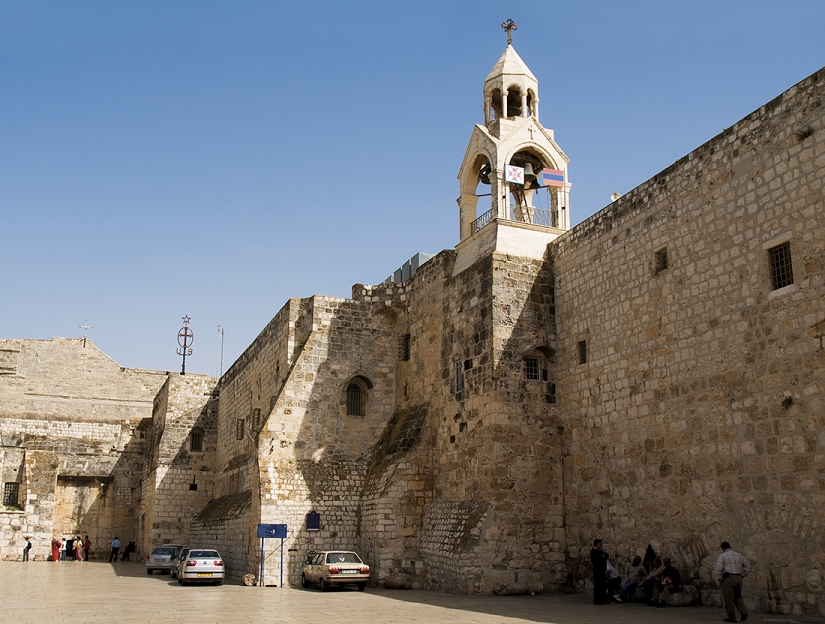
the basilic "Nativity" in Bithlehem. Its construction began in 325 AD.
Peace between religions
When we climbed back up, the city was already wide awake and Armenian priests were preparing for their service. The complex of the Church of the Nativity is run by Orthodox, Armenian and Catholics together who have an agreement to officiate in a particular order. Just like in the Holy Sepulchre in Jerusalem, there reigns tolerance, envisioned by many but achieved by few.
Emperor Hadrian built a temple dedicated to Adonis above the cave of nativity, following the practice adopted by Romans to extinguish the sparks of the new faith by turning its shrines to temples devoted to their gods. Then Constantine the Great destroyed it and built a basilica with five naves in its place in the fourth century.
Since the original temple was burned down, the church which stands today dates back to from the sixth century. Under the lids, one meter below the current floor, one can see ancient floor mosaics from twelfth century. Pieces of mosaics are also found on the walls and the columns; they are made of gold and smalt (pieces of coloured stones and pottery used in making mosaics).
In the Nativity complex you can also find the Milk grotto. Here, a drop of milk from Mary's bosom dropped on the ground while she was nursing Infant Jesus. Today the white soil from this place is given to the barren woman to help them conceive.
Bethlehem nights
Celebrating Christmas in Jerusalem is an old tradition, as old as celebrating Easter in Jerusalem. Thousands of pilgrims, tourists and clergymen from around world take part in the lavish celebrations and processions. For a whole month the city relives the most significant event in its history because each of the Christian communities celebrates Christmas on a different date - Catholics and Protestants on 25th December, most Orthodox - on January 6th and Armenian Christians - on January 25th.
Days before Christmas Eve, the city is festively decorated, the streets are glimmering with Christmas lights, Christmas carols and nativity plays are being performed. Every Christian home has a cross painted on the front door and a nativity scene arranged on the window sill; in the main square of the city there is a huge bright star.
On Christmas Eve a Christmas parade passing through the streets of Bethlehem. Residents and visitors of the town flock to the temple to witness the festive procession. The procession enters silently through the door of the ancient basilica and lays down an ancient statue of the Infant on a special altar.
According to the Gospel of Luke shortly before the birth of Jesus, his mother Mary went with her husband Joseph to his hometown Bethlehem since Emperor Augustus had issued an order for a census of the population of the empire and everyone had to be recorded where his family came from. Mary and Joseph could not find a place in the inn, and were forced to seek shelter in a cave outside the town, where shepherds kept their sheep.
At the moment of birth an extraordinary light shone bright in the sky and an angel appeared who told the shepherds the good news of great joy. „But the angel said to them, "Do not be afraid. I bring you good news that will cause great joy for all the people.
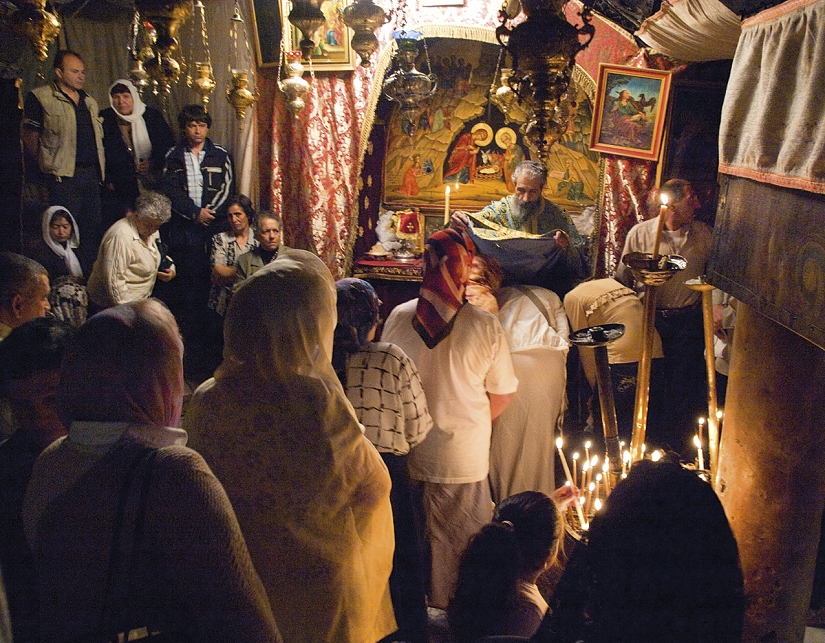
Worshippers in front of the cave of Nativity.
Today in the town of David a Saviour has been born to you; he is the Messiah, the Lord. This will be a sign to you: You will find a baby wrapped in cloths and lying in a manger." Suddenly a great company of the heavenly host appeared with the angel, praising God and saying, "Glory to God in the highest heaven, and on earth peace to those on whom his favour rests." Thus the Bethlehem shepherds were the first to worship the God Son. The infant was also worshiped by three Eastern kings who were led to him by the Star of Bethlehem.
The first step on the holy path described in the Gospels, is not Bethlehem, however, but it lies to the north – in Nazareth, where a heavenly angel announced to Virgin Mary that she would bear the Saviour; she returned there three years after the birth and Jesus grew up in Nazareth until he was 13 years of age.
The home of Saint Joseph the Betrothed, which was a two-room house of adobe bricks, is no longer in Nazareth. The only story that remains is how four angels picked it up and transported it to the far-away Italian town of Loreto in 1291, to save it from desecration by the Saracens. At the place where home of Mary and Joseph stood and where the Annunciation took place, Christians now perform their rights in an Orthodox and Catholic Church.
Money changers in the temple
Near Nazareth is the place where Christ performed his first miracle –the well-known Cana of Galilee, where Jesus turned water into wine during a wedding feast. It is located near the Sea of Galilee, where the Godson found his first students among the local fishermen.
Here is also Tabgha – the place where the next miracle called the Feeding of the multitude was performed; with two fish and five loaves of bread Christ managed to feed 5000 people.
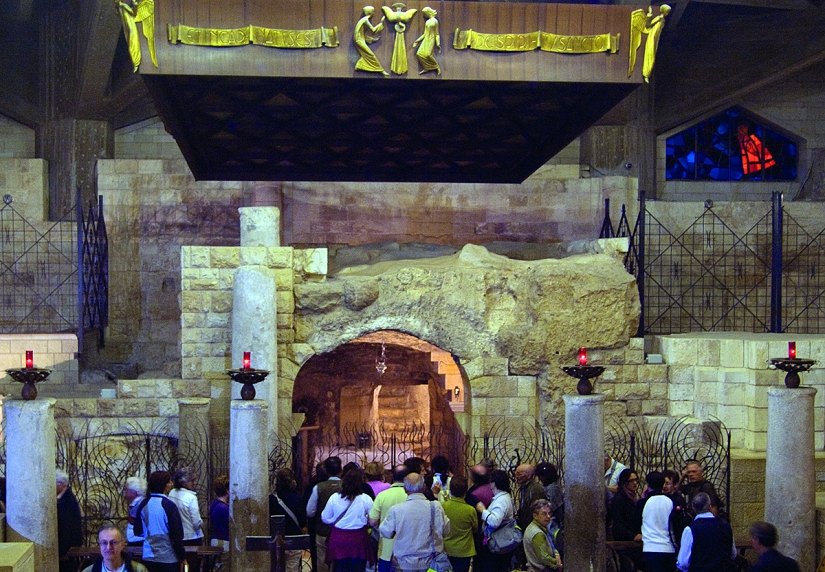
this is the cave where Joseph and Mary lived.
For centuries, Christian pilgrims have been travelling around the Holy Land strictly following each step of Christ, but pilgrims nowadays have little in common with those in the past. Merchants not unlike the money changers the Saviour once expelled from the temple can now be seen at every corner.
The ritual bathing in the River Jordan is no longer done at the place where the Godson was baptized by St. John the Baptist; it is near the border with Jordan and the region is occupied by the military. Instead, a dam was built near Yardenit in order to make a place large enough for the purposes of bathing and baptism; there are changing rooms, shops and cafes.
Everything here indicates that bathing in the river is a profitable business. Once a wild and desolate desert where Jesus roamed for 40 days and 40 nights, the place is now tamed by kibbutzim. The Holy Sepulchre is in one of the Arab districts of Jerusalem, a city sacred to three religions now.
For the Christians it is associated with Christ's crucifixion and resurrection. Muslims believe that here Muhammad ascended to heaven to receive guidance on how Muslims should pray. For the Jews Jerusalem is the city of Temple Mount is where God was worshiped through offering sacrifices. Long before Jesus and Muhammad were born, the city was sacred and wars were fought for the right to hold it.
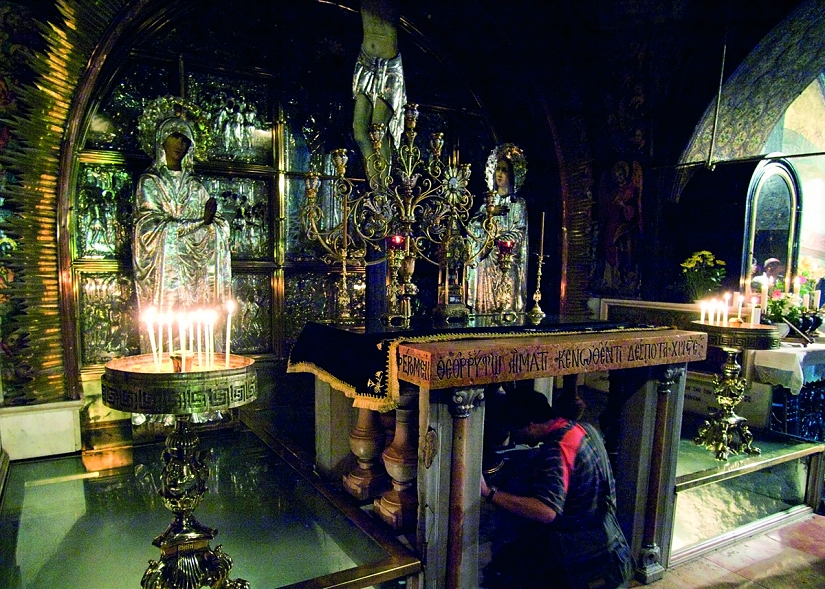
Golgotha, the place where Jesus was crucified.
Who is the Mother of God
After the establishment of Christianity as a world religion, the cult of the Virgin Mary became particularly popular. It was a new expression of the age-old imagery of the Mother Goddess. There is not a word about her descent and childhood in the Gospels, which generally offer scarcely little information concerning her person.
The apocryphal Gospel of the birth of Mary also known as Protoevangelium of James is almost the only literary source, which sheds light on this unknown part of her biography. According to him, Mary was the daughter of the righteous Joachim and Anna, who were childless until at an advanced age. Her unexpected birth resembles of the birth of Isaac to the old Abraham and Sarah.
At the age of 3 Maria was presented to the temple where she was brought up and educated in virtue. At the age of 12 she gave a vow of celibacy and a husband had to be found for her who would protect her and respect her vow. By divine providence, Joseph was chosen to be her betrothed among other contenders by lot. In her husband's home in Nazareth Mary tirelessly spun yarn for the temple's veil. According to the interpretations this was a symbolic "spinning" and weaving of the Body of Jesus Christ and the purple was the blood in her womb.
That was the life of Mary until the Annunciation. At the place of the well where she went to take water and where the holy Archangel Gabriel announced the holy event, early Christians built a church, which was later destroyed; it was subsequently rebuilt by the crusaders.
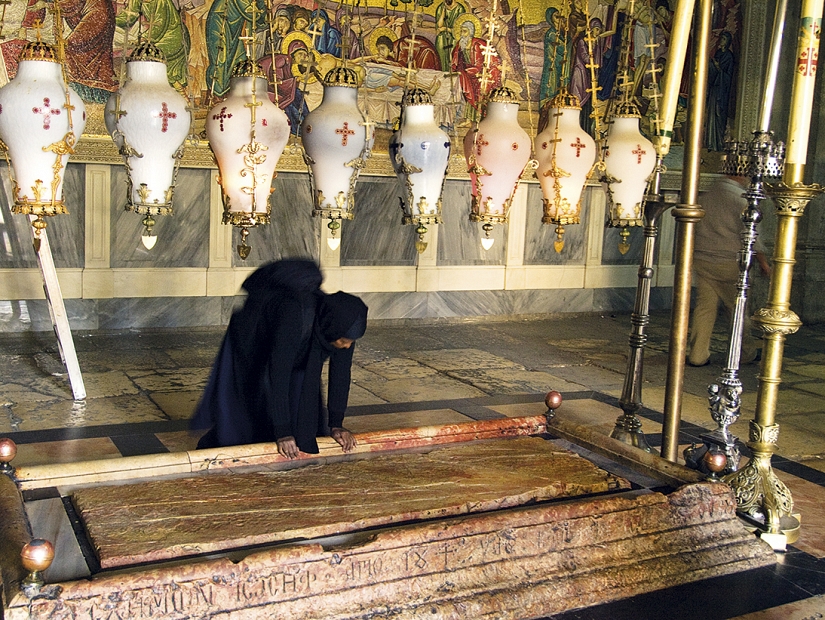
The stone bed on which lay the body of Christ, where three days after the Crucifixion he ressurected. Above it burn candles of all faiths. If the temple is crowded by too much devotees at a time, a person has no more than a minute to knee and pray.
300-year-old Icons
We descended the steep stairs leading to the dim underground temple in Jerusalem, where the grave of the Mother of God was. On the one of its sides there are surprisingly well-preserved Orthodox icons, which are more than 300 years old; on the other side there are Armenian ones.
Although significantly younger, they are damaged at the bottom, because during floods the underground was filled with water. However, the once miraculous icon, known as the Lady of Jerusalem rose in the air and barred the hole, through which the water was pouring in, thus protecting the Orthodox icons.
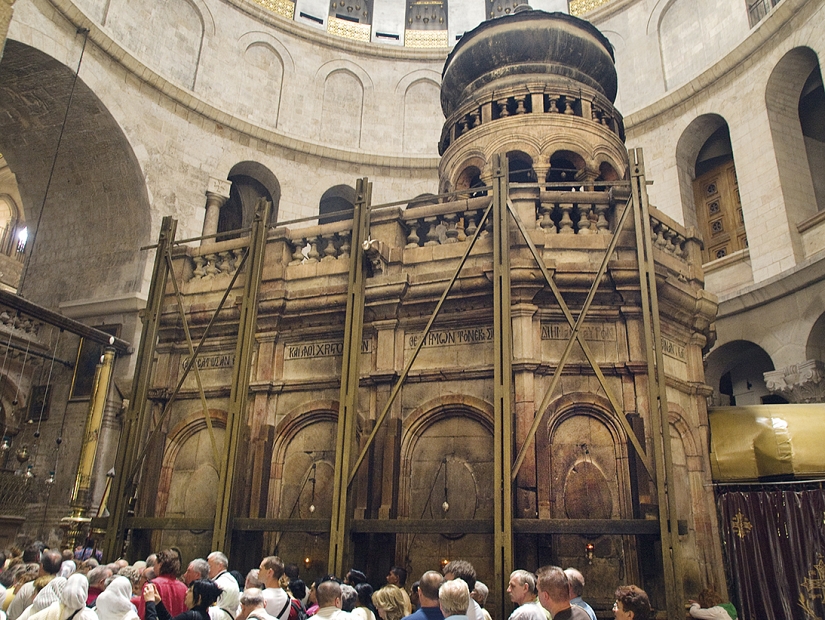
Holy Sepulchre - a church in the church. The inner one was once affected by an earthquake and now supported by rails.
This miraculous icon is one of most valuable relics of Christianity. It is believed to be a portrait of Mary painted by St Luke and therefore accurately depicting her features. According to historians, however, Luke appeared on the historical scene after 6th century but this fact has never discouraged believers.
The miraculous Icon visited Bulgaria in the year 2000. Crowds of believers went to worship it. Through it they also worshiped Christ, who, with his birth, brought into this world a fraction of the sacred heavenly peace.


Our pilgrimage was incomparably shorter and easier than the one of earlier Hajji as they had to travel for months by ships, camels and mules in order to take from the holy fire of divine light. Nevertheless, it was still an invaluable lesson because, while you are tracing the footsteps of the God-man in the Holy Lands, rather than just reading about it the Gospels, you are nourishing not only your mind, but also your senses, and most importantly – your heart.
It is in our hearts that we cherish the eternal light which first shone bright in the morning skies two thousand years ago, heralding the birth of the Messiah. Bethlehem is located only twenty kilometres south of Jerusalem in the hilly region of Galilee, which is now notorious for its frequent outbreaks of violence; yet to us it appeared to be just a small peaceful provincial city. Refugees from the former Palestinian territories outnumber the Christian population, but there is an agreement which states that the mayor and most councillors must be Christians.
The Manger of the Infant
The Church of the Nativity, which is built over the sacred cave, closely resembles a fortress. It is honoured as the oldest functioning Christian church. This place has been attracting pilgrims for more than sixteen centuries - since 326. It was the year when the mother of the Roman Emperor Constantine the Great –Empress Helena, went searching for the cave where Christ was born according to the gospel of Luke.
On an early Sunday morning we stepped over the threshold of this holy place together with some of the most fervent Bethlehem Christians. We descended into the famous cave following a narrow stairway. There is a 14-point silver star set into the floor of the Grotto with an inscription in Latin: „Here of the Virgin Mary Jesus Christ was born."
We waited for our turn to bow down and touch with our foreheads this holy spot. The infant's manger was in a niche in the wall. There is no altar in the church and the priest held a mass in front of a niche with images of the nativity above the star. Gradually the small intimate place became rather too small and intimate because of the many people inside.
A young priest sang in Greek followed by several local men singing along with their beautiful voices in Arabic; it was obvious that all of us were experiencing this moment as some kind of revelation. At least, that is how we felt in the humble church, pressed against the crowd of people, all staring at the niche in awe and prayer.

the basilic "Nativity" in Bithlehem. Its construction began in 325 AD.
Peace between religions
When we climbed back up, the city was already wide awake and Armenian priests were preparing for their service. The complex of the Church of the Nativity is run by Orthodox, Armenian and Catholics together who have an agreement to officiate in a particular order. Just like in the Holy Sepulchre in Jerusalem, there reigns tolerance, envisioned by many but achieved by few.
Emperor Hadrian built a temple dedicated to Adonis above the cave of nativity, following the practice adopted by Romans to extinguish the sparks of the new faith by turning its shrines to temples devoted to their gods. Then Constantine the Great destroyed it and built a basilica with five naves in its place in the fourth century.
Since the original temple was burned down, the church which stands today dates back to from the sixth century. Under the lids, one meter below the current floor, one can see ancient floor mosaics from twelfth century. Pieces of mosaics are also found on the walls and the columns; they are made of gold and smalt (pieces of coloured stones and pottery used in making mosaics).
In the Nativity complex you can also find the Milk grotto. Here, a drop of milk from Mary's bosom dropped on the ground while she was nursing Infant Jesus. Today the white soil from this place is given to the barren woman to help them conceive.
Bethlehem nights
Celebrating Christmas in Jerusalem is an old tradition, as old as celebrating Easter in Jerusalem. Thousands of pilgrims, tourists and clergymen from around world take part in the lavish celebrations and processions. For a whole month the city relives the most significant event in its history because each of the Christian communities celebrates Christmas on a different date - Catholics and Protestants on 25th December, most Orthodox - on January 6th and Armenian Christians - on January 25th.
Days before Christmas Eve, the city is festively decorated, the streets are glimmering with Christmas lights, Christmas carols and nativity plays are being performed. Every Christian home has a cross painted on the front door and a nativity scene arranged on the window sill; in the main square of the city there is a huge bright star.
On Christmas Eve a Christmas parade passing through the streets of Bethlehem. Residents and visitors of the town flock to the temple to witness the festive procession. The procession enters silently through the door of the ancient basilica and lays down an ancient statue of the Infant on a special altar.
According to the Gospel of Luke shortly before the birth of Jesus, his mother Mary went with her husband Joseph to his hometown Bethlehem since Emperor Augustus had issued an order for a census of the population of the empire and everyone had to be recorded where his family came from. Mary and Joseph could not find a place in the inn, and were forced to seek shelter in a cave outside the town, where shepherds kept their sheep.
At the moment of birth an extraordinary light shone bright in the sky and an angel appeared who told the shepherds the good news of great joy. „But the angel said to them, "Do not be afraid. I bring you good news that will cause great joy for all the people.

Worshippers in front of the cave of Nativity.
Today in the town of David a Saviour has been born to you; he is the Messiah, the Lord. This will be a sign to you: You will find a baby wrapped in cloths and lying in a manger." Suddenly a great company of the heavenly host appeared with the angel, praising God and saying, "Glory to God in the highest heaven, and on earth peace to those on whom his favour rests." Thus the Bethlehem shepherds were the first to worship the God Son. The infant was also worshiped by three Eastern kings who were led to him by the Star of Bethlehem.
The first step on the holy path described in the Gospels, is not Bethlehem, however, but it lies to the north – in Nazareth, where a heavenly angel announced to Virgin Mary that she would bear the Saviour; she returned there three years after the birth and Jesus grew up in Nazareth until he was 13 years of age.
The home of Saint Joseph the Betrothed, which was a two-room house of adobe bricks, is no longer in Nazareth. The only story that remains is how four angels picked it up and transported it to the far-away Italian town of Loreto in 1291, to save it from desecration by the Saracens. At the place where home of Mary and Joseph stood and where the Annunciation took place, Christians now perform their rights in an Orthodox and Catholic Church.
Money changers in the temple
Near Nazareth is the place where Christ performed his first miracle –the well-known Cana of Galilee, where Jesus turned water into wine during a wedding feast. It is located near the Sea of Galilee, where the Godson found his first students among the local fishermen.
Here is also Tabgha – the place where the next miracle called the Feeding of the multitude was performed; with two fish and five loaves of bread Christ managed to feed 5000 people.

this is the cave where Joseph and Mary lived.
For centuries, Christian pilgrims have been travelling around the Holy Land strictly following each step of Christ, but pilgrims nowadays have little in common with those in the past. Merchants not unlike the money changers the Saviour once expelled from the temple can now be seen at every corner.
The ritual bathing in the River Jordan is no longer done at the place where the Godson was baptized by St. John the Baptist; it is near the border with Jordan and the region is occupied by the military. Instead, a dam was built near Yardenit in order to make a place large enough for the purposes of bathing and baptism; there are changing rooms, shops and cafes.
Everything here indicates that bathing in the river is a profitable business. Once a wild and desolate desert where Jesus roamed for 40 days and 40 nights, the place is now tamed by kibbutzim. The Holy Sepulchre is in one of the Arab districts of Jerusalem, a city sacred to three religions now.
For the Christians it is associated with Christ's crucifixion and resurrection. Muslims believe that here Muhammad ascended to heaven to receive guidance on how Muslims should pray. For the Jews Jerusalem is the city of Temple Mount is where God was worshiped through offering sacrifices. Long before Jesus and Muhammad were born, the city was sacred and wars were fought for the right to hold it.

Golgotha, the place where Jesus was crucified.
Who is the Mother of God
After the establishment of Christianity as a world religion, the cult of the Virgin Mary became particularly popular. It was a new expression of the age-old imagery of the Mother Goddess. There is not a word about her descent and childhood in the Gospels, which generally offer scarcely little information concerning her person.
The apocryphal Gospel of the birth of Mary also known as Protoevangelium of James is almost the only literary source, which sheds light on this unknown part of her biography. According to him, Mary was the daughter of the righteous Joachim and Anna, who were childless until at an advanced age. Her unexpected birth resembles of the birth of Isaac to the old Abraham and Sarah.
At the age of 3 Maria was presented to the temple where she was brought up and educated in virtue. At the age of 12 she gave a vow of celibacy and a husband had to be found for her who would protect her and respect her vow. By divine providence, Joseph was chosen to be her betrothed among other contenders by lot. In her husband's home in Nazareth Mary tirelessly spun yarn for the temple's veil. According to the interpretations this was a symbolic "spinning" and weaving of the Body of Jesus Christ and the purple was the blood in her womb.
That was the life of Mary until the Annunciation. At the place of the well where she went to take water and where the holy Archangel Gabriel announced the holy event, early Christians built a church, which was later destroyed; it was subsequently rebuilt by the crusaders.

The stone bed on which lay the body of Christ, where three days after the Crucifixion he ressurected. Above it burn candles of all faiths. If the temple is crowded by too much devotees at a time, a person has no more than a minute to knee and pray.
300-year-old Icons
We descended the steep stairs leading to the dim underground temple in Jerusalem, where the grave of the Mother of God was. On the one of its sides there are surprisingly well-preserved Orthodox icons, which are more than 300 years old; on the other side there are Armenian ones.
Although significantly younger, they are damaged at the bottom, because during floods the underground was filled with water. However, the once miraculous icon, known as the Lady of Jerusalem rose in the air and barred the hole, through which the water was pouring in, thus protecting the Orthodox icons.

Holy Sepulchre - a church in the church. The inner one was once affected by an earthquake and now supported by rails.
This miraculous icon is one of most valuable relics of Christianity. It is believed to be a portrait of Mary painted by St Luke and therefore accurately depicting her features. According to historians, however, Luke appeared on the historical scene after 6th century but this fact has never discouraged believers.
The miraculous Icon visited Bulgaria in the year 2000. Crowds of believers went to worship it. Through it they also worshiped Christ, who, with his birth, brought into this world a fraction of the sacred heavenly peace.

Sirni Zagovezni
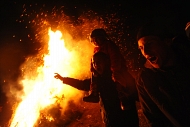
an ortodox firy ritual strenghtens the family relations view more »
The colourful people
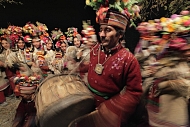
Buddhist dards from the Himalayas start melting into global monotony view more »

